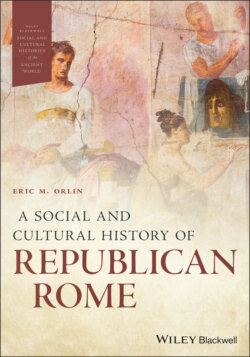Читать книгу A Social and Cultural History of Republican Rome - Группа авторов - Страница 18
Inscriptions
ОглавлениеInscriptions left on permanent materials (generally stone or bronze), many of which turned up in the course of archaeological excavations, provide a second crucial source from material culture. Some inscriptions offer information about the practice of politics in Rome and Italy: electoral graffiti on the walls of Pompeii gives glimpses into the ways in which political campaigns were waged. Similarly, two town charters apparently drawn up by Julius Caesar and published shortly after his death offer insight into government structures, from magistrates to the grain dole. One of the most famous Republican inscriptions, the so-called Senatorial decree de Bacchanalibus (“on the Bacchanalians”) (Figure 1.5) is of interest not only for information about certain religious behaviors but also because it was found in southern Italy and so can tell us something about the relationship of the Roman Senate to the cities of Italy. In addition, the fasti, Roman calendars inscribed on stone, not only help us order the Roman year with its festivals and other holidays but also provide chronological information about magistrates and triumphs. As with any source, we need to ask questions about why a given document was published: why did the Roman state feel the need to tell everyone in Italy about their treatment of a particular religious practice? Why was it felt necessary to start posting calendars in different towns across Italy? However, these documents are invaluable because they provide direct evidence for contemporary Roman behavior.
Figure 1.5 Bronze tablet recording the Senatorial decree on the worship of Bacchus, 186 BCE. Kunsthistorisches Museum Vienna.
Just as with archaeology, the less impressive inscriptions often have a greater impact on our understanding of Roman society. Two types in particular stand out: dedications (usually to one or more divinities) and burial epitaphs, both of which give us insight into the behavior of the non-elites that would otherwise be missing. Dedications can help us understand actual rather than idealized religious behavior, showing us to which gods people expressed their gratitude and for what purposes. On occasion they present a picture that never would have been evident from the literary sources. For instance, the literary sources pay little attention to the god Faunus, but his popularity is attested by numerous dedications far beyond anything we would have imagined from the literary evidence. That discovery forces us to ask both what made Faunus so popular, and with whom, and why he did not attract the attention of the elites. It thus raises new questions for the historian: a history of religious behavior at Rome simply cannot be written without inscriptional evidence.
In a similar fashion burial epitaphs can tell us a great deal about Roman life among both the elite and non-elite. We are fortunate to possess some epitaphs of famous Romans known from the literary sources, such as members of the Scipiones who conquered Carthage. These materials not only deepen the understanding gained from the literary sources but also allow us to see how the family members wished to be perceived. Ordinary Romans also wanted to be commemorated after death and we can look at their tombstones to compare their practices to the elite and ask in what ways they shared in a common understanding of death, the afterlife, or even family relationships. In addition to these monuments, we have large numbers of simpler tombstones bearing minimal text but which attest to the desire of the lower classes to leave a memorial behind even with their limited resources. The large number of tombstones allows us to ask questions about which members felt a duty to erect a monument and which family members they felt they needed to remember. We can also explore the language and images used on these tombstones to understand the nature of relationships within the family or the values that ordinary Romans held dear. These inscriptions often offer an intimate look into the lives of Romans that cannot be matched by other sources.
